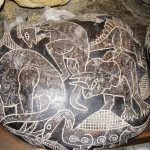Featured image attribution and link:
A Dinosaur Discovered in a Mammal’s Stomach?!
by Brad Harrub, Ph.D.
People are up in arms in Dover, Pennsylvania, because of the school board’s decision to teach Intelligent Design along with evolutionary theory. Battle lines have been drawn, and lawsuits have been filed. The American Civil Liberties Union (ACLU) has filed a lawsuit on behalf of eleven parents, stating that this is “creationism in disguise,” and thus it is not “real science.” They contend that the only scientific theory that should be permitted in the classroom is the godless theory of organic evolution. After all, it is the only one that is “scientific.” I wonder if the ACLU has stopped its legal intimidation tactics long enough to actually look at the latest scientific data? If members of the ACLU truly want to keep “real science” in the classroom, then they should be rolling out the red carpet for theories other than organic evolution. In fact, one discovery has evolutionary spin-doctors popping antacids as they scramble to provide the general public with another “just-so” story.
Consider the following evidence. Most evolutionary timelines have the mammals evolving from reptiles. Indeed, the textbook I used in my freshman general biology class noted: “During the Mesozoic Era the reptiles, which had evolved earlier from the amphibians, became dominant and in turn gave rise to the mammals and the birds” (Raven and Johnson, 1989, p. 432). George Gaylord Simpson contended that, according to standard evolutionary theory, no advanced mammals were present in the “age of the dinosaurs.” The dinosaurs, he suggested, became extinct in the Cretaceous Period, and the only mammals that had evolved up to that point (even at the very end of the period) were “small, mostly about mouse-sized, and rare” (1957, p. 797, emp. added). This is a logical explanation if you are going to contend that mammals evolved from reptiles, because it would require that mammals appeared much later in the picture.
Evolutionists consider the last 65 million years of Earth history (the Cenozoic Era) to be the “age of the mammals.” However, the discovery of several small mammalian fossils has challenged such notions.
For instance, in 2001, a report that coincided with evolutionists’ beliefs regarding the evolution of mammals received front-page status. A small mouse-like creature, designated as Hadrocodium, was discovered in the Lufeng deposits of Yunnan Province, China (Luo, et al., 2001). The suggestion was that this small mouse-sized creature was one of the front-runners for man’s early mammalian ancestor. Thus, evolutionary theory had to receive a “few minor tweaks” in order to suggest that mammals evolved millions of years earlier than expected, and that some mammals actually coexisted with the dinosaurs. The scientific literature was quick to point out, however, that these creatures were probably “small and nocturnal.”
A discovery reported in the January 13, 2005, issue of Nature challenged everything evolutionists have ever maintained regarding dinosaurs and mammals. The Associated Press reported: “Villagers digging in China’s rich fossil beds have uncovered the preserved remains of a tiny dinosaur in the belly of a mammal, a startling discovery for scientists who have long believed early mammals couldn’t possibly attack and eat a dinosaur” (Verrengia, 2005). Not only do we now have additional proof of mammals coexisting with dinosaurs, but we also have scientific evidence of a large mammal eating a dinosaur! The authors discovered the fossil remains of two different mammals. One was 50% larger than previous mammal fossils that were considered to be living with the dinosaurs, and was named Repenomamus giganticus. The other, Repenomamus robustus was fully intact—and had a dinosaur in its stomach. Yaoming Hu and his colleagues noted:
During preparation of the specimen a patch of small bones was revealed within the ribcage, on the ventral sides of the posterior left thoracic ribs and vertebrae, where the stomach is positioned in extant mammals. Unduplicated dentition [teeth—BH], limb bones and phalanges [bones of the toes or “fingers”—BH] in the patch confirm that these bones belong to a juvenile individual of Psittacosaurus, an herbivorous dinosaur that is common in Jehol Biota. The serrated teeth in the patched skeleton are typical of juvenile Psittacosaurus. The skull and most of the skeleton of the juvenile Psittacosaurus are broken, disarticulated and displaced, in contrast to the preservation of the R. robustus skeleton, which is essentially in its original anatomical relation. Although fragmentary, the bones of the Psittacosaurus are packed in a restricted area. These conditions indicate that the juvenile skeleton of Psittacosaurus is the remaining stomach contents of the mammal (Hu, et al., 2005, 433:151).
In discussing this amazing find, Nature writer Anne Weil observed: “Discoveries of large, carnivorous mammals from the Cretaceous challenge the long-held view that primitive mammals were small and uninteresting. Have paleontologists been asking the wrong question?” (2005, 433:116). Maybe a better question would be: Have paleontologists been analyzing the data through muddled evolutionary glasses? Yet, keep in mind that the ACLU and the National Center for Science Education are actively waging war on anyone who questions evolutionary theory being taught in a school classroom.
Remember George Gaylord Simpson’s summation? He suggested that mammals were “small, mostly mouse-sized, and rare.” Yet as Weil noted in Nature, these creatures hardly could be described as either “small” or “mouse-sized.” In commenting on the two skeletons that were discovered, she noted: “Neither is of a small mammal. One is more than a meter long. The other appears to have a dismembered juvenile dinosaur in its stomach” (433:116). This discovery calls into question every speculation evolutionists have set forth regarding the dinosaurs.
For example, most textbooks written today record that even the size that mammals reached was ultimately determined by the dinosaurs. Allegedly, as long as dinosaurs were in the picture, mammals were forced to remain small, and had to scavenge for food at night. The Web site for the Museum of Paleontology, sponsored by the University of California, Berkeley, lists what evolutionists consider to be invalid hypothesis for what killed the dinosaurs. One of those “invalid” hypotheses is:
Mammals outcompeted the dinosaurs?—Better still, but not easily falsifiable and not upheld by any evidence. We cannot reconstruct the late Cretaceous ecosystem and see if the mammals were outcompeting the dinosaurs for food, space, or other resources; the fossil record is too poor and does not preserve behavior well. We know that dinosaurs and mammals evolved together for most of the Mesozoic era; mammals remained quite small and only slowly increased in diversity (Museum of Paleontology, n.d.).
Consider for a moment how many times evolutionary theory has been completely contradicted by the evidence. We have scientific proof of elephant prints and dinosaur prints in the same location. We have scientific evidence of dinosaur petroglyphs etched into stone walls by men living just a few hundred of years ago. We have scientific evidence of large mammals eating dinosaurs. The scientific evidence continues to support creation by an intelligent Designer. Yet, this is the one theory that the ACLU contends must be kept far away from students! It will be only a matter of time before evolutionary spin-doctors place this latest find into a quiet, dark closet—where (if you’ll pardon the pun) it will remain alongside other questionable skeletons. But at some point we must ask ourselves, how many times are we going to throw out the data and keep evolutionary theory, rather than accepting the scientific data and throwing out evolutionary theory?
REFERENCES
Hu, Yaoming, Jin Meng, Yuanqing Wang, and Chuankui Li (2005), “Large Mesozoic Mammals Fed on Young Dinosaurs,” Nature, 433:149-152, January 13.
Luo, Zhe-Xi, Alfred W. Crompton, and Ai-Lin Sun (2001), “A New Mammaliaform from the Early Jurassic and Evolution of Mammalian Characteristics,” Science, 292:1535-1540, May 25.
Museum of Paleontology, (no date), “What Killed the Dinosaurs,” [On-line], URL: http://www.ucmp.berkeley.edu/diapsids/extincthypo.html.
Raven, Peter H. and George B. Johnson (1989), Biology, (St. Louis, MO: Times Mirror/Mosby College Publishing), second edition.
Simpson, George Gaylord, C.S. Pittendrigh and L.H. Tiffany (1957), Life: An Introduction to Biology (New York: Harcourt, Brace & Company).
Verrengia, Joseph B. (2005), “Fossils Show a Mammal Turned Tables, Devoured Dinosaur for Last Meal,” [On-line], URL: http://www.cp.org/english/online/full/science/050112/g011204A.html.
Weil, Anne (2005), “Living Large in the Cretaceous,” Nature, 433:16, January 13.







